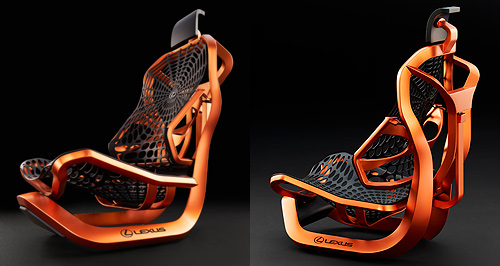News - LexusParis show: Lexus puts passengers on the webSpider sense: Lexus’ conceptual seat doesn’t just use a spider web pattern to support occupants more effectively, it is also partly constructed using synthetic spider silk. Revolutionary Kinetic Seat Concept weaves silky spider secrets into Lexus seats16 Sep 2016 WHILE the world’s car-makers gear up to reveal a range of vehicle concepts at the Paris motor show this month, Lexus will debut an evolution of the humble car seat dubbed the Kinetic Seat Concept. The radical design study drops the conventional cushions, leather and springs of more customary seating in favour of unique construction and materials, for a product that the Japanese car-maker says provides comfort for longer periods as well as looking like no other. A rotating seat base and articulated back rest allows the occupant’s body to move with the forces applied to it during driving, which helps the head stay relatively still. Lexus says the effect is similar to a runner’s head staying upright and relatively stable and promotes a more stable field of vision as well as reducing fatigue on longer journeys. Where bulky cushions and fabric is used to cover more orthodox vehicle seats, Lexus’ solution uses a spider web pattern of strands to support the passenger, but its arachnid connection is more than just an aesthetic trick with the fibres produced using a revolutionary synthetic spider silk. Japanese materials specialist Spiber was enlisted to assist in creating the seat web, lending its expertise in synthesising fibres produced from complex protein arrangements, in a technique learned from spider silk production. The Spiber material is light, strong, and flexible for greater occupant comfort without adding to vehicle weight but is also made using a process that impacts the environment less than the petrochemical industry – where many fabrics and fibres originate. Not only does the special web support and hug the occupant more effectively, the shoulder support portion allows the chest to rotate around the seats’ centre axis, increasing head stability. By using minimalist construction methods and materials the Kinetic seat is lighter but also slimmer, and occupies less vehicle interior space. Little is said about the Kinetic Seat Concept’s main frame, which appears to be manufactured from orange anodised aluminium and adds a striking look to the mould-breaking seat. Lexus fans will be suspicious of the car-maker crying wolf, following an April fool gag this year, that claimed to introduce a Variable Load Coupling Rear Orientation System or V-LCRO seat for the RC-F coupe. The supposed revolutionary sportscar seat used a Velcro-like upholstery material to secure an occupant in place as long as they were wearing clothing made from the other half of the special fabric. While the Kinetic seat will remain a concept for now, it does, at least appear to offer more legitimate design potential than the company’s April fool wind-up. Lexus will not just be exhibiting furniture at the show later this month and has also chalked the reveal of its UX compact SUV concept for the Paris show.  Read more |
Click to shareLexus articlesMotor industry news |
































Facebook Twitter Instagram